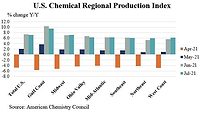ACC Reports Chemical Production in US Ended on a High Note




WASHINGTON – The U.S. Chemical Production Regional Index (U.S. CPRI) rose 1.2% in December following a 0.6% gain in November and a 1.2% increase in October, according to the American Chemistry Council (ACC). During December, chemical output grew in all regions, with the largest gains occurring in the Gulf Coast and Midwest regions. Chemical production expanded in all segments except miscellaneous other inorganic chemicals. The U.S. CPRI is measured on a three-month moving average (3MMA) basis.
As nearly all manufactured goods are produced using chemistry in some form, manufacturing activity is an important indicator for chemical demand. The manufacturing recovery continued for a sixth straight month in December, with overall factory activity up 1.1% (3MMA). The trend in production rose in nearly all key chemistry end-use industries, with the strongest gains seen in iron and steel, appliances, aerospace, construction supplies, foundries, plastic products, tires, paper, structural panels, and apparel.
Compared with December 2019, U.S. chemical production was off 2.7%, the nineteenth consecutive month of year-over-year declines, but reflecting improvement versus earlier in the year. Chemical production remained lower than a year ago in all regions, with the largest year-ago declines seen in the Northeast, Mid-Atlantic and West Coast regions.
The chemistry industry is one of the largest industries in the United States, a $565 billion enterprise. The manufacturing sector is the largest consumer of chemical products, and 96% of manufactured goods are directly touched by chemistry. The U.S. CPRI was developed to track chemical production activity in seven regions of the United States. The U.S. CPRI is based on information from the Federal Reserve, and includes monthly revisions as published by the Federal Reserve. To smooth month-to-month fluctuations, the U.S. CPRI is measured using a three-month moving average. The reading in December reflects production activity during October, November and December.
Looking for a reprint of this article?
From high-res PDFs to custom plaques, order your copy today!









